Homemade Cultured Buttermilk is going to be a game changer for you. It’s literally as easy as mixing two things in a jar.
And whoa are you going to love having all that fresh homemade cultured buttermilk around. Read or scroll through to the end for great ideas on how to use up your real buttermilk.
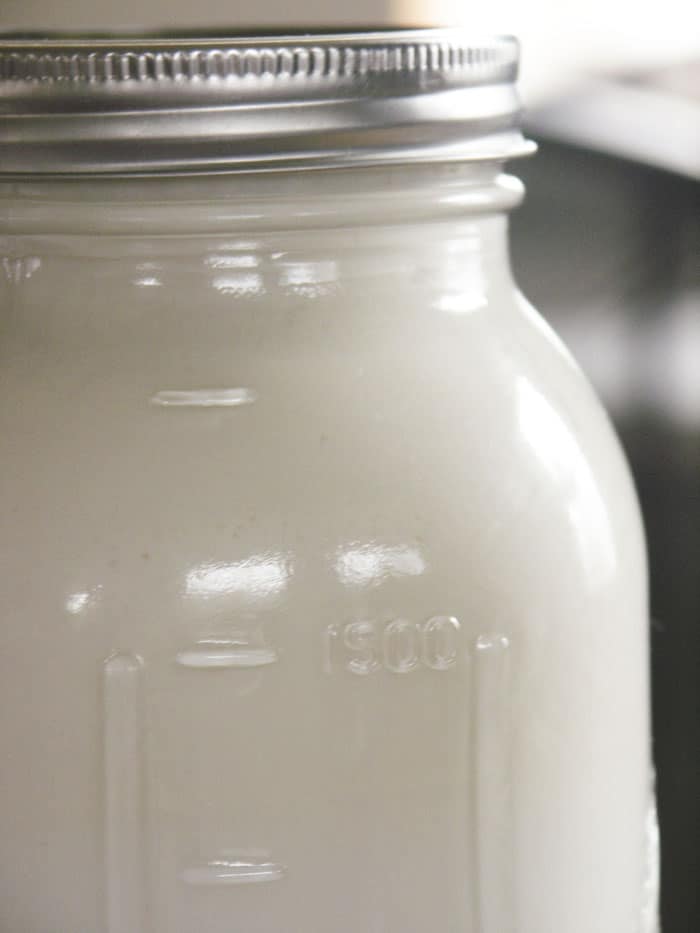
I use a lot of homemade buttermilk. And by ‘a lot’ I mean a ton.
Many of my baked goods contain buttermilk. Much of my salad dressing uses buttermilk.
And my beloved, The Evil Genius? He drinks buttermilk.
Now before any of you out there yawp with a resounding, “EW!” let me just mention that millions of Southerners and displaced Southerners are right now saying, “Mmmmmmmm! A nice tall glass of buttermilk with salt and pepper sounds mighty fine right now.”
A reminder: never yuck another person’s yum. Unless we’re talking durian, then all bets are off… (You may want to read about my family vs. Durian.)
We go through a lot of the stuff. And I may have mentioned that I live in the middle of nowhere in Amish country before (or a million times before, but who’s counting?) so frequent last minute trips to the store are not convenient.
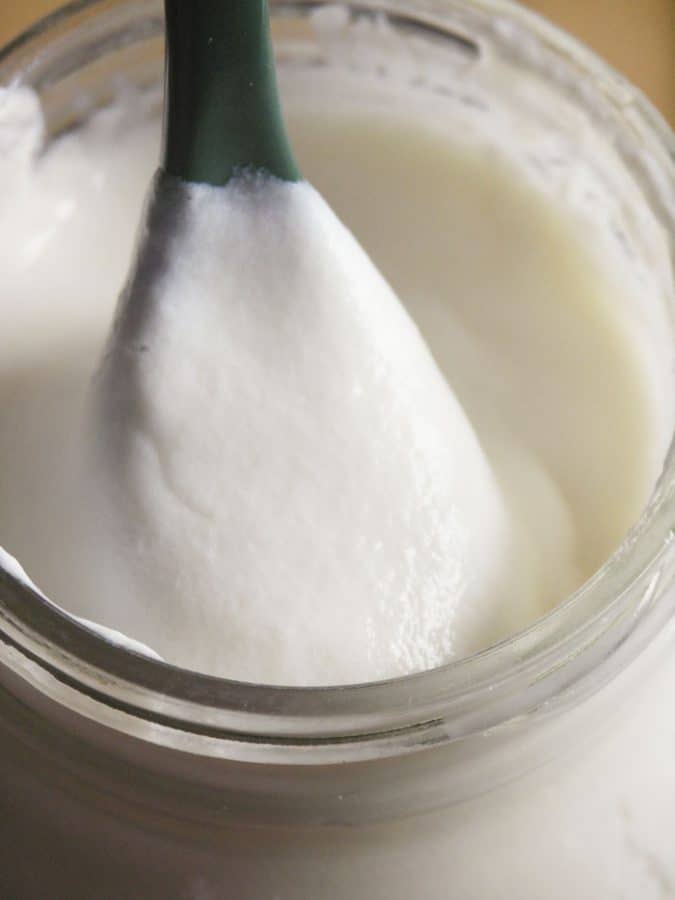
How to Make Real Buttermilk
There are probably quite a few of you out there saying, “Oh please. All you have to do is add a little vinegar or lemon juice to milk and you get the same thing. Why buy buttermilk?”
See? I just knew someone out there was saying it. Not so fast! It’s not the same thing. To prove my point, I have to talk science for a moment.
While the acidified milk might give you the same tang of buttermilk, it lacks woefully in the texture and viscosity department.
Buttermilk is used in recipes for several important reasons. First, it is acidic, so it helps invigorate leavening agents -such as baking powder, baking soda and yeast- when added to baked goods.
The acid also helps combat discoloration in baked goods and promotes deep, beautiful browning. Buttermilk contains natural emulsifiers; this improves texture and aroma, and extends shelf life after baking.
The acidity of your homemade cultured buttermilk makes it a wonderful addition to marinades for chicken and pork. The acid helps tenderize the meat and gives it a tangy flavor.
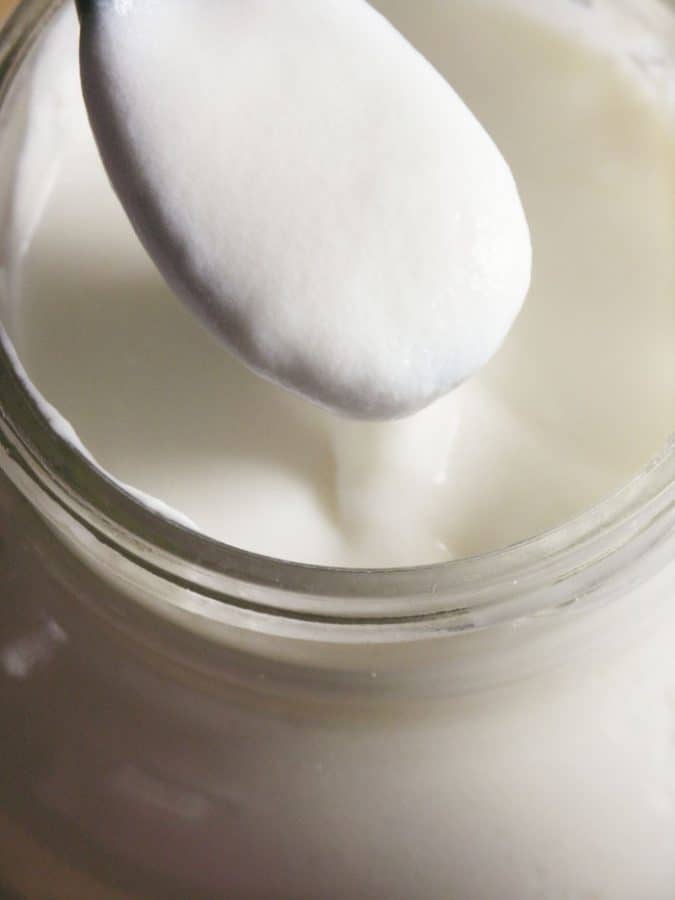
Cultured Buttermilk
You know the ‘cultured’ part of cultured buttermilk? It’s good for you.
It contains many active cultures similar to those found in yogurt. Most of the cultures generally found in buttermilk are form the Lactococcus Lactis family and many of their subspecies.
Those cultures are what make homemade cultured buttermilk so thick and creamy. And what? Good for you!
Now that you know more than you probably ever wanted to know about buttermilk let’s get onto the ‘Why make my own?’ thing. Because you can.
Seriously. You need more than that?
Okay. Also make it because it’s dirt cheap, it’s super simple, it’s really fun and you’ll never run out of buttermilk again.
Hang on one second. Someone out there just said, “I never use a whole thing of buttermilk. What do I do with all that buttermilk?” I’m so glad you asked. How about a few of these ideas:
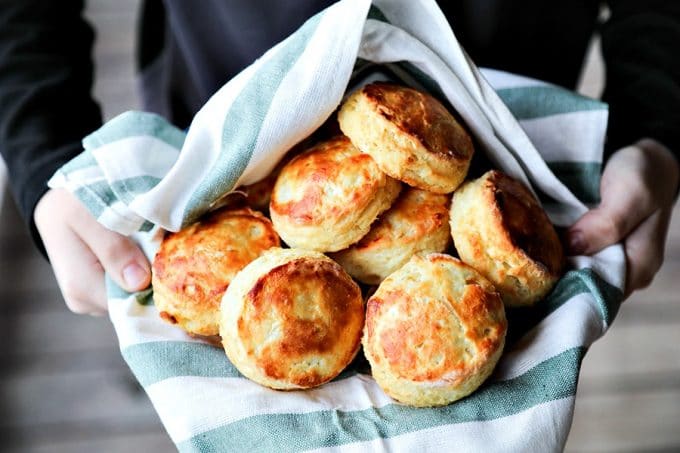
Perfect, flaky, Homemade Buttermilk Biscuit Take it from me, these buttermilk biscuits would do my Arkansas Grandma proud… They’re lofty, flaky, tender, and utterly divine.
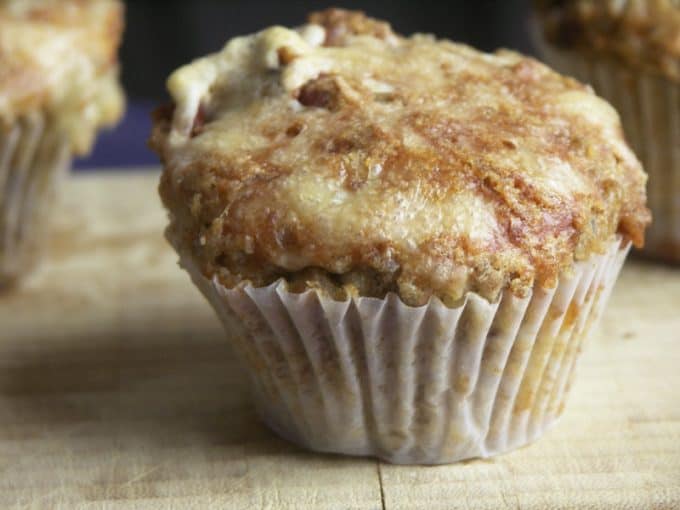
Bacon and Swiss Rye Muffins These are every bit as good as they sound and as easy as pie. No wait! They’re easier than pie. Pie can be hard.
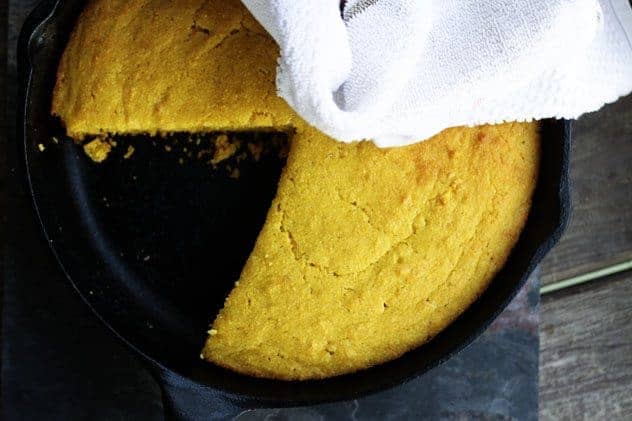
Grandma’s Buttermilk Cornbread This is my Grandma’s buttermilk cornbread recipe and it is ridiculously delicious and the ultimate comfort food.

Buttermilk Cornbread Rounds Based on my Grandma’s Buttermilk Cornbread recipe, these perfectly portioned cornbread rounds fit neatly in the hand and go anywhere cornbread goes, but look cuter doing it! This one’s going a little way back in the FWF archives.
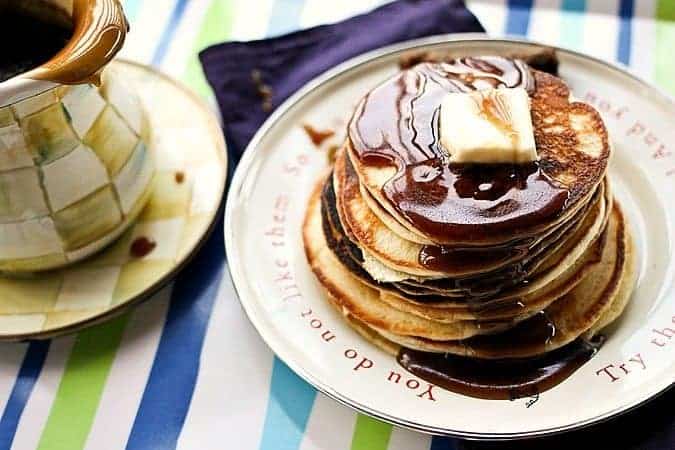
Buttermilk Pancakes Nothing beats beautiful, light, airy buttermilk pancakes smothered in real maple syrup. Nothing. This one’s also reaching way back.

Garam Masala Depression Cake from Val. Nothin’ depressing about THAT cake, I’ll tell you. We’re talking about a decadent, Garam Masala flavored chocolate cake with orange buttercream and toasted coconut.
Oh my. I only take issue with the number of servings Val specified in it. It looks like a one-person cake to me.
I would be remiss if I didn’t mention these others…
- Chocolate Chip Breakfast Cookies (Drop scones)
- Extra Crispy Fried Chicken Fingers (The Evil Genius can cook!)
- Cornbread Salad
Are you good and hungry yet? Excellent. Let’s make some buttermilk. I promise it doesn’t take but two shakes.
Homemade Cultured Buttermilk
Scroll to the bottom for an easy-print version of this recipe!
Ingredients:
- 1/4 to 1/2 cup cultured buttermilk (from the store or home cultured)
- 1 to 2 quarts skim,1%, 2%, or whole milk from the store or raw milk
Also needed:
- 1 clean, dry quart or half gallon jar with a tight fitting two piece lid.
Okay. Ready? If you blink you’ll miss how to do it.
Pour buttermilk (1/4 cup for a quart jar or 1/2 cup for a half gallon jar) into your clean jar. Top off the jar with your plain milk.
Tightly screw lid to the jar and shake vigorously for 1 minute. Place in a warm (but not hot) area out of direct sunlight.
Let it sit there for 12 to 24 hours, until thickened. Refrigerate when thick.
Use within two weeks. If you re-culture this regularly, you can carry on re-culturing indefinitely.
Now here’s a glimpse of my finished product. Note that mine is super thick. I used raw, whole milk to culture my buttermilk. If you use skim, it may end up a little thinner than what you see here.
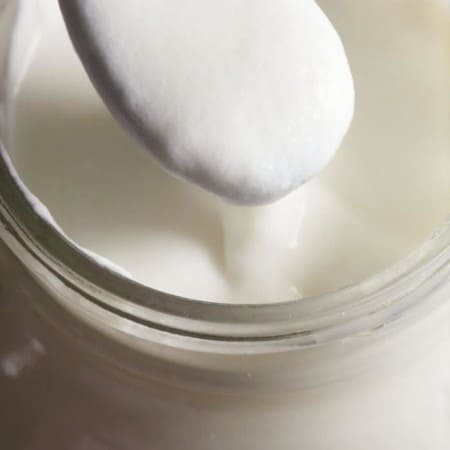
Homemade Cultured Buttermilk
Rate RecipeIngredients
- 1/4 to 1/2 cup cultured buttermilk from the store or home cultured
- 1 to 2 quarts skim 1%, 2%, or whole milk from the store or raw milk
- Also needed:
- 1 clean dry quart or half gallon jar with a tight fitting two piece lid.
Instructions
- Okay. Ready? If you blink you’ll miss how to do it.
- Pour buttermilk (1/4 cup for a quart jar or 1/2 cup for a half gallon jar) into your clean jar. Top off the jar with your plain milk. Tightly screw lid to the jar and shake vigorously for 1 minute. Place in a warm (but not hot) area out of direct sunlight. Let it sit there for 12 to 24 hours, until thickened. Refrigerate when thick. Use within two weeks.
Notes
Nutritional information is an estimate and provided to you as a courtesy. You should calculate the nutritional information with the actual ingredients used in your recipe using your preferred nutrition calculator.
did you make this recipe?
Make sure to tag @foodiewithfam on Instagram and #hashtag it #foodiewithfamily so I can check it out!
This recipe was originally posted March 24, 2010, and was updated with photos, links, and improved notes March 2021.
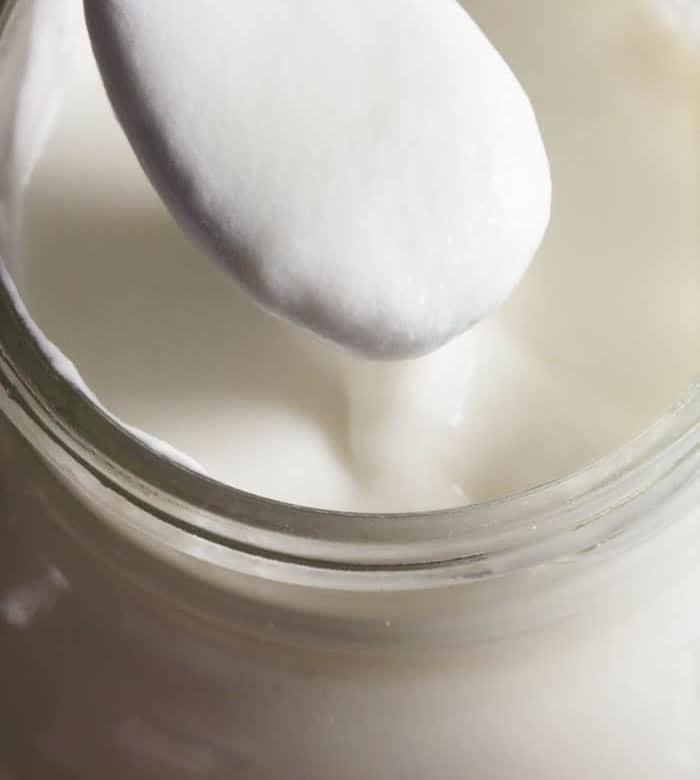



Reader's Thoughts...
Suzanne says
Thank you for the recipe. How long will buttermilk last in the fridge after you’ve made it? When is it a good idea to toss out?
Donna says
Well, if I’d taken time to read all the comments, I would have found the answer to my questions. Duh. How dumb does that feel!
Thanks, y’all.
Rebecca says
Don’t feel dumb I’m glad you found your solution!
Donna says
I hope someone can help me out here. I’ve made this twice; thick and delicious! How-everrr… it is syrupy. What is that about. I used 1/2 C Knudsen’s cultured buttermilk in a quart mason jar, filled it up (about 3-1/2 C) with Alta Dena whole milk. 24 hrs later, very thick, buttermilk. But when I pour it, it is syrupy. The second batch tasted almost like very thick cream. But, can’t figure out why it’s syrupy. Can anybody (please) answer that one?
Elaine says
It works best if you heat the milk to 85F before adding the cultured buttermilk. I use 1/2 cup culture to 1 quart milk and leave it on th kitchen counter for 24 hrs covered with a cloth. It’s perfect every time!
Chuck says
Going to try making BM. Family use to when I was young using this recipe, made in one gal. crock pot covered with a towel and whole goats milk. I have kept & used store BM that was over a year and half old. NO problems tasted good. Just have to shake it good as it settles. I know older BM is best for pancakes. lighter, fluffier.
Teresa says
The buttermilk was 1 1/2 years old?
Meredith Bernard says
Hi! I’m excited to read this post. You are also a great writer. 😉 I have never made homemade “anything”, but recently quit my full-time sales job to stay home and raise my children (and grow a photography business). We live on a beef cattle farm, but last week my husband bought a Jersey milk cow. So now we have fresh, wonderful, delicious milk daily. I have an electric churn that was his mothers (50 years old!), but it still works. I don’t know how to use it, though. We are letting the milk sit in it and it’s getting warm, but not “clabbering”. (Sp?) He added some store bought buttermilk, but I’m wondering if we need to add more “culture” I see mentioned above…what is that and where do I buy it? Sorry to be so ignorant, but I really want to figure this out and start using this milk to make butter and buttermilk! And maybe one day…cheese? Eek!
Patricia says
I have made b/m before using the same instructions but this time it came out differnt:
I used a cultured store bought buttermilk and raw milk to make my buttermilk. It became so thick over night you can scoop it with a spoon and has no taste.
What did I do wrong?
Kim Jermeay says
I have tried this method 3 times and each time very unsuccessful. The milk breaks down into small chunks through out the whey. I use a heating pad on low with auto shut-off after 3 hours, in a pot covered with towels. I think I am going back to heating the milk to 160′, cooling to 120′ or lower then adding the buttermilk and wrapping in a towel place in a tall pot to keep warm for 12-24 hours. Not sure if using raw milk for your buttermilk really works. Thanks.
Ellen says
I made it with store bought cultured buttermilk and 2 percent milk. I live in a cold climate at a high altitude. I really don’t have a very consistently warm spot in the house, so I let it culture in a cold oven with the light on to create warmth. It definitely thickened and cultured, look more like yogurt and had tiny lumps throughout. It smelled ok and I consumed a big glass sprinkled with salt as it tasted good too. I hope I don’t get sick.
Cathy says
How do you make the buttermilk that you add to the regular milk? I have a cup of fresh buttermilk leftover from making butter from raw milk. What do I use to culture that? Does it create its own culture? Thanks.
Rebecca says
I buy cultured buttermilk at the store to start it. I honestly don’t know if your raw buttermilk (in the old fashioned sense of the word) would form it’s own culture… I don’t mean to deter you, I just honestly don’t know!
sherrie says
I want to know if anybody has tried to can buttermilk?
I can not find a recipe anywhere.
Thank YOu
Rebecca says
Hi there… I’m pretty sure buttermilk cannot be canned. Most dairy is not approved for canning because even in a sealed jar, it can go rancid. Additionally, buttermilk has a live bacterial culture in it that would most certainly be killed during the processing… I don’t advise it even if you find a recipe that says its okay!
Angie says
I’ve cultured yogurt, kefir, and various other milk products from raw goat’s milk repeatedly over the years, so I would add that if you leave this too long, especially if it separates, that your end product will be more acidic and sour to taste. Also, I noticed some people having problems, but I wonder if that could be due to over pasteurization instead of temperature. If the milk is overly pasteurized, it ruins it for cheesemaking, so it very well could destroy the globules enough that they will not culture properly either. 🙂 Just my two cents! Good recipe.
Vanessa says
I just tried this and am a little afraid to use it because it doesn’t smell or taste like the buttermilk I bought from the store at all. It’s almost a little sweet. Is that normal? I followed the recipe exactly for a quart. I used store bought buttermilk and 1% milk. I let it sit out for about 14 hours and it’s very thick (my house is warm since it’s summer – about 76 degrees). Could it be that it’s too warm? Should still use it or throw it out and try again?
Thanks for your help!
Rebecca says
I think you’ll be okay! You’re putting happy bacteria in and that should hinder the growth of the bad stuff. It’d be really hard for milk to go so bad it would be dangerous in 24 hours particularly when it’s cultured. That being said, if you’re nervous, bake with it or feed it to the dogs or cats!
Teresa says
What do you mean it would be dangerous in 24 hours when it is cultured? How do you know if it is bad? Lol. Sorry. We are just so conditioned in America milk has to be refrigerated.
jim boles says
I love buttermilk (BM) and drink about 3 quarts a week. The two qualities I like most is that it has to taste sour and it has to be rich. BM that is only 1% isn’t rich enough for me. Problem is, the typical BM found in stores really isn’t very good by those criteria.
We moved to Cedar Rapids Iowa several years ago and I found BM made by Kalona dairy in Amish country (isn’t Amish though). Their products are very lightly pasteurized and not homogenized. Consequently, the milk cultures aren’t killed in the pasteurization process. They simply make the best butter milk I ever had. Too bad it is $3.95 a quart!
I’ve tried making my own with some success, but it was typically too thick and not sour enough.
So, one day I bought a quart of Kalona’s plain yogurt which normally taste on the sour side. The store didn’t have any Kalona BM so I bought the normal stuff that I dislike. I went home and put two tablespoons of the yogurt into a glass of the BM and used an electric drink mixer in the glass to mix it well…. and Whaa La! great tasting BM and at a cheap price. Hmmm, I did have to buy the yogurt too so I’m not sure how much money I saved exactly, but the yogurt will last a long time, because I’m not using that much per quart of BM.
Just thought I share this idea. As much as I drink, making my own BM, or buying it a $3.95 a quart wasn’t the way to go.
If you’re ever in southeast Iowa stop by the Kalona dairy and try their BM. It’s great!
John says
Wow too easy and so much less additives than store bought. I use organic 2% and follow the recipie for 18 hours at room temp. Thanks!
Terri says
I tried this but mine didn’t get overly thick and it separated. One part was white and thicker and one part was yellow and watery. It smells like buttermilk but I’m a little nervous to use it. Did anyone else have this issue? I kept it out for 29 hours at room temperature.
Felicia says
When the milk separates like that it just means it cultured a bit longer than necessary. My kefir does the same thing when the house is warmer than usual. Just put the lid back on and shake it back together. Or you could put it in the blender.
Verano en Vermont says
Hi,
Rather than starting a homemade buttermilk recipe w. a base of store-bought buttermilk, I’d like to add culture to the raw milk we regularly buy from a farmer down the road. I’m not clear on how to procure the organisms, or in what form they come. Is it something one buys from a health food store? Is it a liquid? A powder? Other?) How would I add it to the raw milk as a first step to following your buttermilk recipe? How much would I add to the recipe, and is it something I’d just throw in to the overall mixture? Also, I’m curious…the local organic cultured yogurt we buy seems to have more, or perhaps a wider range of cultures than the buttermilk we buy…can I substitute yogurt instead of buttermilk in your cultured buttermilk recipe? Kindly address as many of my questions as you are able!
Thanks!
Verano en Vermont
Indiana b-milk says
If you have raw milk, you do not need to buy a culture. I get raw milk from our farmer..to make buttermilk, skim the cream, then let it sit on the counter in a jar with a lid (not screwed tight-wide mouth is best) until it is so thick that when you tilt the jar the cream does not move. This can take 1-2 days. I usually do this before our next milk run when I have had the cream for a week. The culturing may take longer if done right away. There will be bubbles along the inside of the glass. Make sure when you put the cream in the bowl you do NOT have any much milk in there..(use a slotted spoon) a milk line will have formed while it was culturing..if You leave it in it will not work. TRUST ME. Then proceed to make butter..I use my kitchenaid mixer. I found a good youtube video on this a while back..you basically whip it up into whipped cream, then keep whipping till it goes all the way back down and starts to separate. This can take an hour sometimes….that’s when I’m glad I don’t have to use my arm!! You have to squeeze the butter globules together on the inside of the bowl with a flat paddle (like a salad paddle kinda)..wood is best..it becomes nonstick like nothing else will over time. Pour off the buttermilk you are squeezing out of the butter..this is real buttermilk..the method mentioned here is simulated buttermilk..just uses the culture from store bought to culture the milk…BTW..you must “wash” the butter with cold water..just google that..it’s not very hard. (There are organisms in raw milk that will culture naturally. You don’t have to add anything. The cultured butter you end up with also has those beneficial organisms in it…it will be tangy like yogurt. Hope this works for you!
sharon says
We culture our buttermilk the ‘old-fashioned’ way – letting it clabber. Raw milk doesn’t spoil, it sours and can be turned into all sorts of lovely stuff. One buttermilk sat around far too long and really thickened, then separated, we made it into a tangy cheese.
Teresa says
My daughter went to Germany in 2002. She said in the grocery the milk is not refrigerated. It is still in glass jars, on a shelf. How long is raw milk good left out like this? I would think it would spoil quick! Like a day? I am curious. What do you make with all “the lovely stuff” it turns into? Ty!
Janice Bearbower says
What are your thoughts about the water bath at 100 deg.–we don’t have a wood stove…..all electric home.
Janice Bearbower says
I,, too, have trouble with warm spot – tried the water bath as for yogurt right at 100 degrees – still working — getting thick on top – do you shake it periodically – (don’t shake yogurt) we keep our home about 67-68 is that too cool? Thanks, could you please respond to my email…thanks so very much.
Rebecca says
I wouldn’t shake it while it’s culturing, but I would definitely shake it afterward. 67-68 is too cool to culture in the timeframe I gave. You can let it sit at that temperature, but it will take longer to thicken. I put mine behind my woodstove where it’s about 75-80 degrees at most times.
Teresa says
Could it take 2 days at the lower temp? Or maybe longer? What do you do during the summer when your wood stove isn’t on? Ty!
Rebecca says
I let it culture at room temp then. It seems to go pretty quickly when it’s hot and humid out!
Joan says
I found your site a couple of months ago, Love it!! Thanks to you I have it and use it on a constant basis.